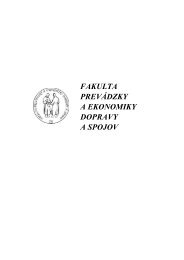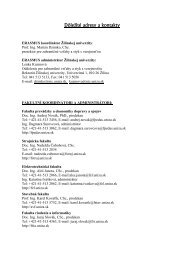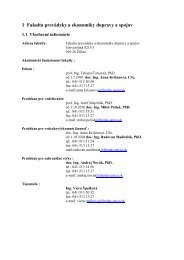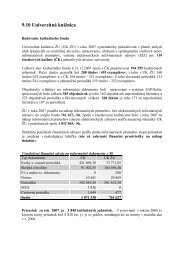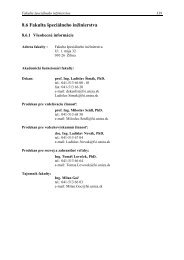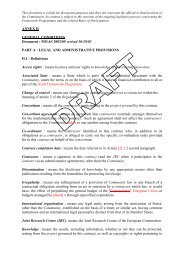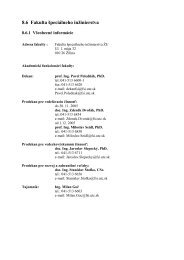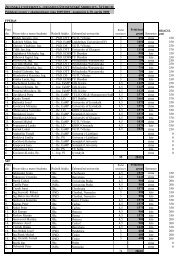posudzovanie vplyvu automobilovej dopravy na - Žilinská univerzita
posudzovanie vplyvu automobilovej dopravy na - Žilinská univerzita
posudzovanie vplyvu automobilovej dopravy na - Žilinská univerzita
Create successful ePaper yourself
Turn your PDF publications into a flip-book with our unique Google optimized e-Paper software.
C O M M U N I C A T I O N S<br />
I S<br />
one is a thermal method, and it can be employed in the processes<br />
of reduction taking place in the engine cylinder and partially in the<br />
exhaust system owing to a relatively high temperature of exhaust<br />
gases to which the reducing agent is added. However, outside the<br />
cylinder, the effectiveness of this method is low because of a rapid<br />
drop in the exhaust gas temperature. This temperature depends on<br />
the diesel engine operating conditions and, in the exhaust systems,<br />
ranges from 373 to 423K when the engine is idling, from 423 to<br />
623K in urban traffic (low and medium loads and engine speeds),<br />
and from 623 to 1023K on a highway. In order to employ the SNR<br />
method to reduce nitrogen oxides it would be necessary to heat up<br />
exhaust gases, which involves energy losses.<br />
In the engine exhaust system it is more favourable to use a catalytic<br />
converter which reduces NO x emissions by means of the<br />
SCR method. An extensive development of this method, with an<br />
application to engine exhaust gases, started in the eighties. Similarly<br />
as in the chemical industry and statio<strong>na</strong>ry power plants, nitrogen-containing<br />
compounds, such as ammonia or urea, are usually<br />
considered as nitrogen oxide reducing agents. Various test results<br />
indicate that ammonia used in a catalytic converter to reduce the<br />
concentration of nitrogen oxides in the diesel engine exhaust gases<br />
provides high reduction efficiency exceeding 90%. The use of this<br />
reducing agent is, however, not practical owing to its toxicity, explosiveness<br />
in a mixture with air, and also by a sharp and unpleasant<br />
odour. Additio<strong>na</strong>lly, it would be necessary to use pressure vessels<br />
for the transportation of ammonia. Consequently, urea as an indirect<br />
source of ammonia seems to be more useful in this application.<br />
Urea used as a non-toxic source of ammonia is a safe reducing<br />
agent. Additio<strong>na</strong>lly, its good solubility in water facilitates transportation<br />
in diluted form. As a result of injecting urea into hot<br />
exhaust gases (having a temperature above 430K) before the catalytic<br />
converter, the first reaction taking place is the hydrolysis of<br />
urea, during which ammonia and other compounds such as NH 2<br />
are produced (one kilogram of urea yields 0.566 kg of ammonia).<br />
Assuming the NO to NO 2 ratio of 9:1, which is valid for the diesel<br />
engine exhaust gases, it can be calculated that to reduce 1 kg of<br />
NO x , about 0.67 kg of urea is needed [9]. The efficiency of NO x<br />
reduction depends both on the reduction process conditions and<br />
on the amount of urea used.<br />
It must be emphasised that in order to use urea and/or ammonia<br />
in traction engines it would be necessary to employ a costly system<br />
dosing these reducing agents adequately to engine operating conditions<br />
(NO x content of exhaust gases), and periodically replenishing<br />
the tank with the reducing agent. It would be also necessary to<br />
build a complete distribution system for ammonia or urea, and to<br />
take protective measures against the effects caused by a potential<br />
escape of toxic ammonia to the atmosphere from the engine<br />
exhaust system. Thus the use of the selective catalytic reduction of<br />
nitrogen oxides by means of nitrogen-based compounds is better<br />
justified in industrial diesel engines or in engines installed on<br />
ships, while for traction diesel engines powering motor vehicles it<br />
is more appropriate to focus research activities on the use of other<br />
reducing agents, such as hydrocarbons.<br />
2. Studies of NO x Reduction with Hydrocarbons<br />
Publications on that subject usually describe the results of tests<br />
conducted in laboratory conditions. Such tests usually involve the<br />
reduction of nitrogen oxides contained in a mixture prepared from<br />
gases stored in pressure gas vessels and having similar composition<br />
to that of the actual diesel engine exhaust gases. To investigate<br />
the effects of NO x reduction by the SCR method, hydrocarbons<br />
(also from a pressure gas vessel) were introduced into such gaseous<br />
mixtures flowing through a catalytic reactor. Less results of tests<br />
conducted with actual diesel engine exhaust gases are available. In<br />
such tests, the following substances were used to reduce nitrogen<br />
oxides: hydrogen H 2 , gaseous hydrocarbons CH 4 , C2H 4 , C 3 H 6 ,<br />
etc. [7, 10, 12, 13], alcohols [4, 7, 14, 15] and hydrocarbons contained<br />
in diesel fuel. Diesel fuel was usually injected into the exhaust<br />
system, before the catalytic reactor [5, 10, 12, 13, 17, 18].<br />
Because of its temperature, the location where hydrocarbons<br />
are added to exhaust gases has a considerable influence on the<br />
process of nitrogen oxide reduction, as it is related to the amount<br />
and chemical activity of radicals generated during the initial decomposition<br />
of hydrocarbon molecules. The most favourable solution<br />
seems to be the injection of an additio<strong>na</strong>l hydrocarbons directly<br />
into the cylinder, where they would be subjected to the initial<br />
decomposition. High temperature of the working medium and longer<br />
time of the initial decomposition of hydrocarbon molecules would<br />
be the advantages of such a solution. Considering possible engineering<br />
applications, the method of dosing the reducing agent into<br />
the cylinder has more advantages. This method was used in the tests<br />
described here, where additio<strong>na</strong>l hydrocarbons (contained in diesel<br />
fuel) were introduced directly into the engine cylinder, as a result<br />
of the post-injection of an additio<strong>na</strong>l, small portion of fuel, during<br />
the expansion stroke. Contrary to the main fuel dose injected during<br />
the compression stroke, the additio<strong>na</strong>l fuel dose did not have any<br />
influence on the engine output power.<br />
In order to chemically activate the hydrocarbons, the additio<strong>na</strong>l<br />
fuel dose injected into the cylinder should undergo a similar<br />
physical and chemical transformation as in the autoignition delay<br />
period, i.e. it should produce the so-called cool flame, without<br />
reaching the hot flame state (i.e. autoignition and combustion). In<br />
such conditions, as a result of thermal decomposition of hydrocarbon<br />
molecules and their initial reactions with oxygen contained in<br />
the exhaust gases, chemically active molecules of hydrogen H 2 ,<br />
radicals R ●<br />
(hydrocarbon molecule after loosing one hydrogen<br />
atom), HO 2<br />
●, ROO ● and atomic hydrogen H ● are produced, demonstrating<br />
strong NO x -reducing properties. This method of injecting<br />
additio<strong>na</strong>l fuel dose into the cylinder causes some portion of the<br />
products of partial oxidation of hydrocarbons to react with nitrogen<br />
oxides yet in the engine cylinder (because of high temperature<br />
inside it). Consequently, a part of nitrogen oxides is subjected to<br />
thermal reduction. It must be noted that the radicals taking part in<br />
the process of nitrogen oxide reduction may be also contained in the<br />
products of water, carbon monoxide, and carbon dioxide dissociation,<br />
generated by burning the main fuel dose [19, 22, 23].<br />
Reactions of NO x reduction taking place in a catalytic reactor<br />
have different course than thermal reactions, and their mechanism<br />
KOMUNIKÁCIE / COMMUNICATIONS 1/2003 ●<br />
27



